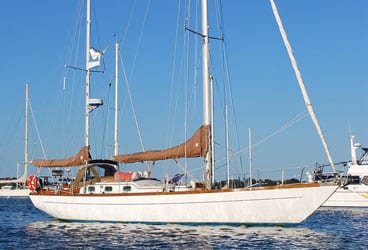
Reliance 44
Several years ago, when my husband, Green, and I went cruising on our first boat, I learned to appreciate the importance of having clear decks to work on and a safe interior with plenty of handholds. These points were on my mind when an online listing for a Reliance 44 caught my eye. Her traditional lines and ketch rig made her look like she’d go places.
Designed and built by Pierre Meunier in Montréal, Reliance 44s were available either as a hull and deck to be finished by the owner or in various stages of completion from the factory. Since many, including my own, were finished by the original owners, there are vast differences between boats in terms of cabin layout, hardware, and the general quality of the interior. The hull and deck are constructed of hand-laid fiberglass with a 1-inch balsa core. The core provides for a stiff hull that’s much lighter than solid glass, and the additional insulating effect has been a bonus for living aboard through New England winters. There’s solid fiberglass in the important places: the chainplates, deck fittings, and keel. The fiberglass work is top-notch, and delamination hasn’t been an issue with our boat or with any other Reliance that we’ve encountered. Meunier was one of the first builders to utilize temperature and humidity control during layup.
Our boat, Lyra, has definitely gone places. She’s been around the world and has several additional transatlantic runs under her keel. With this in mind, we expected to discover issues with the bulkhead tabbing or water intrusion in the balsa core. However, our pre-purchase survey revealed no such problems.
We’ve now owned Lyra for three years, and she’s exceeded our expectations in just about every way (read “At Home Afloat,” Jen Brett’s blog, here). Laid up in 1975 and splashed in 1980, she’s certainly a classic, but with a few system upgrades, she’s become a comfortable, modern cruising boat.
Under sail, the helm is easily felt and balances well. She’s also fairly quick—200-mile days aren’t out of the question. Below the waterline, she features a modified full keel and attached rudder, so she tracks well once the sails are trimmed properly.
Below, there’s plenty of storage, substantial fiddles around the countertops, and excellent handholds everywhere. By contemporary standards, she’s narrow, so she’s not as spacious as other 44-footers. There’s a large sail locker aft of the chain locker, which also cuts into interior space. The two bunks to port and starboard in the aft cabin are excellent sea berths.
A 40-horsepower diesel was the standard auxiliary in the Reliance 44, which may be considered underpowered these days, and my only real beef with the boat is access to the engine. On our boat, it’s located beneath the galley “island”; moving that is a two-person job, and not something that can be done easily at sea.
The June 1981 issue of Cruising World describes the Reliance 44 as a “sturdy and pretty boat that will stand out in any crowd of modern cruising boats.” Now, 30 years later, it’s still true. Depending on the fit and finish, Reliance 44s usually list between $85,000 and $150,000.
Reliance 44
LOA 44′ 4″ (13.5 m.)
LWL 31′ 5″ (9.5 m.)
Beam 11′ 8″ (3.5 m.)
Draft 6′ 2″ (2.1 m.)
Sail Area (100%) 905 sq. ft. (84 sq. m.)
Ballast 11,200 lb. (5,080 kg.)
Displacement 28,000 lb. (12,700 kg.)
Ballast/D .40
D/L 403
SA/D 15.7
Water 200 gal. (757 l.)
Fuel 80 gal. (303 l.)
Holding 30 gal. (113 l.)
Engine 40-hp. Yanmar diesel
Designer Pierre Meunier
Jen Brett, a_ CW_ associate editor, lives aboard her Reliance 44 in Newport, Rhode Island.








